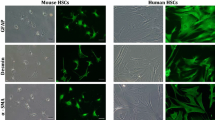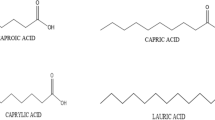Abstract
We report here a study of the incorporation and metabolism of various long chain fatty acids in SK-Hep-1 cultured hepatoma cells. Medium supplementation with radiolabelled palmitic, stearic, linoleic, α-linolenic and eicosa-8, 11,14-trienoic acids (1 µM, 24 H) resulted in an active uptake of each of these precursors by the cultures. Subsequent analysis of the cellular lipids indicated that they exhibit almost all the enzymic activities of polyunsaturated fatty acid metabolism that are characteristic of normal hepatic cells. With respect to the desaturation capacities of this cell line, although α-linolenic acid reacted more extensively than did linoleic acid and the conversion of 8,11,14-eicosatrienoic acid by the Δ 5 specific enzyme was more avid than had been previously seen in normal rat or human liver: the saturated fatty acids constituted relatively poor substrates, being preferentially chain-elongated rather than (mono) desaturated at the Δ 9 position. Analysis of the fatty acid profiles of total cellular lipids and of various lipid subclasses, however, revealed a relative paucity of essential fatty acids when compared with the abundance of endogenous monoenoic acids (particularly oleic). Of the total cellular fatty acids, 58% were present in the form of phospholipids; with 33% of the remaining 42% (i.e., the neutral lipids) being associated with triacylglycerol fraction. Within the total lipids, phosphatidyl-choline and phosphatidyl-ethanolamine were the major sites for the incorporation of all metabolic products derived from the incubated radiolabelled 16- and 18-carbon fatty acid precursors, whereas the phosphatidyl-inositol fraction was the predominat recipient of nascent arachidonic acid when the eicosatrienoate was the substrate. The express purpose of this investigation was to characterize the biochemical routes involved in the anabolism of various essential fatty acids in the human hepatocyte, through the use of cultured human hepatoma cells as an experimental model system. In view of the similarities between certain aspects of the polyunsaturated fatty acid metabolism of these cells and the corresponding properties of other mammalian hepatic or liver-derived tissues, the data presented here would thus constitute a significant beginning alone those lines. Moreover, considering the extreme difficulty in obtaining for such investigation relevant tissue samples from normal human sources, we regard these results — and the availability for use of this particular human hepatoma cell line — as important new developments in the effort to characterize a useful experimental model both for gaining immediate information and for designing future experiments.
Similar content being viewed by others
References
Lands WEM: Control of prostaglandin biosynthesis. Prog Lipid Res 20: 875–884, 1981
Bergstrom S, Bergstrom C: Prostaglandins: from Bedside observations to a family of drugs. Prog Lipid Res 20: 7–12, 1981
Tinoco J: Dietary requirements and functions of α-linolenic acid in animals. Prog Lipid Res 21: 1–46, 1982
Rosenthal MD: Fatty acid metabolism of isolated mammalian cells. Prog Lipid Res 26: 87–124, 1987
Aaes-Jorgensen E: EFA-essentially. Prog Lipid Res 20: 123–128, 1981
Houtsmuller UMT: Columbinic acid, a new type of essential fatty acid. Prog Lipid Res 20: 889–896, 1981
Mead JF: The essential fatty acids: past, present and future. Prog Lipid Res 20: 1–6, 1981
Sinclair HM: The relative importance of essential fatty acids of the linoleic and linolenic families: studies with and Eskimo diet. Prog Lipid Res 20: 897–900, 1981
Sprecher H: Biochemistry of essential fatty acids. Prog Lipid Res 20: 12–22, 1982
Bailey JB, Howard BV, Dumbar LM, Tillman SF: Control of lipid metabolism in cultured cells. Lipids 7: 125–134, 1972
Yavin E, Menkes JH: Polyenoic acid metabolism in cultured dissociated brain cells. J Lipid Res 15: 152–157, 1974
Gaspar G, Alaniz MJT de, Brenner RR: Incorporation and metabolism of stearic, oleic, linoleic, and α-linolenic acids in minimal deviation hepatoma 7288c cells. Mol Cell Biochem 16: 197–203, 1977
Fonck K, Scherphof GL, Konings AWT: Control of fatty acid incorporation in membrane phospholipids X-ray induced changes in fatty acid uptake by tumor cells. Biochim Biophys Acta 692: 406–414, 1982
Marra CA, Alaniz MIT de, Brenner RR: Uptake and metabolism of eicosa-8,11,14-trienoic acid in normal hepatocytes and HTC cells. Mol Cell Biochem 65: 143–152, 1984
Chapkin RS, Miller CC, Somers SD, Erickson KL: Utilization of dihomo-γ-linolenic acid (8,11,14-eicosatrienoic acid) by murine peritoneal macrophages. Biochim Biophys Acta 959: 322–331, 1988
Mandon EC, Gómez Dumm INT de: Biosynthesis of polyunsaturated fatty acids of (n-6) and (n-3) series in isolated adrenocortical cells of rats. Effect of ACTH. Mol Cell Endocrinol 65: 175–185, 1989
Weithmann KV, Peterson H, Sevanian A: Incorporation of arachidonic, dihomogamma linoleic and eicosapentaenoic acids into cultured V-79 cells. Lipids 24: 173–178, 1989
Korte K, McDonald PC, Johnston JM, Okita JR, Casey L: Metabolism of arachidonic acid and prostanoids in human endometrial stroma cells in monolayer culture. Biochim Biophys Acta 752: 423–433, 1983
Yorek MA, Bohnker RR, Dudley DT, Spector AA: Comparative utilization of n-3 fatty acids by cultured human Y-79 retinoblastoma cells. Biochim Biophys Acta 795: 277–285, 1984
Weaver BJ, Holub BJ: The relative incorporation of arachidonic and eicosapentaenoic acids into human platelet phospholipids. Lipids 20: 773–777, 1985
Hayashi I, Larner J, Sato G: Hormonal growth control of cells in culture. In vitro 14: 23–30, 1978
Wilson EJ, McMurray WC: Effects of hormones on the maintenance and mitochondrial functions of rat hepatocytes cultured in serum-free medium. Can J Biochem Cell Biol 61: 636–643, 1983
Grisham JW: Cell types in rat liver cultures: their identification and isolation. Moll Cell Biochem 53/54: 23–33, 1983
Queral AE, De Angelo AB, Garret CT: Effect of different collagenases on the isolation of viable hepatocytes from rat liver. Anal Biochem 138: 235–237, 1984
Horiuti Y, Nakamura T, Ichihara A: Role of serum in maintenance of functional hepatocytes in primary culture. J Biochem 92: 1985–1994, 1982
Ichihara A, Nakamura T, Tanaka K: Use of hepatocytes in primary culture for biochemical studies on liver functions. Mol Cell Biochem 43: 145–160, 1982
Foch J, Trempe G: New human tumor cell line. In: J Fogh (ed.) Human tumor cells in vitro. Plenum Press, New York and London, 1975, pp 115–159
Fogh J, Fogh JM, Orfeo T: One hundred and twenty-seven human tumor cell lines producting tumors in nude mice. J Natl Cancer Inst 59: 221–225, 1977
Thompson EB, Tomkins GM, Curran SF: Induction of tyrosine α-cetoglutarate transaminase by steroid hormones in a newly established tissue culture cell line. Proc Natl Acad Sci USA 56: 296–303, 1966
Alaniz MJT de, Ponz G, Brenner RR: Biosynthesis of unsaturated fatty acids in cultured minimal deviation hepatoma 7288c cells. Acta Physiol Latinoam 25: 1–11, 1975
Richter A, Sanford KK, Evans VJ: Influence of oxygen and culture media on plating efficiency of some mammalian tissue cells. J Nat] Cancer Inst 49: 1705–1712, 1972
Spector AA, Steimberg DS, Tanaka A: Uptake of free fatty acids by Ehrlich ascites tumor cells. J Biol Chem 240: 1032–1041, 1965
Jauregui HO, Hayner NT, Driscoll JL, Williams-Holland R, Lipsky MH, Galletti PM: Trypan blue dye uptake and lactate dehydrogenase in adult rat hepatocytes freshly isolated cells, cell suspensions, and primary monolayer cultures. In vitro 17: 1100–1110, 1981
Lowry OH, Rosebrough NJ, Farr AL, Randall RJ: Protein measurement with the Folin phenol reagent. J Biol Chem 193: 265–275, 1951
Folch J, Lees M, Stanley S: A simple method for the isolation and purification of total lipids from animal tissues. J Biol Chem 226: 497–503, 1957
Matins DC, Mangold HK: Analysis of complex lipid mixtures by thin layer chromatographic and complementary methods. J Am Oil Chem Soc 37: 576–582, 1960
Neskovic NM, Kostic DM: Quantitative analysis of rat liver phospholipids by a two-step thin-layer chromatography procedures. J Chromatog 35: 297–300, 1968
Chen PS, Toribara T, Huber W: Microdetermination of phosphorus. Anal Biochem 28: 1756–1758, 1956
Araki E, Phillips F, Privett OS: Studies on lipid and fatty acid composition of human hepatoma tissue. Lipids 9: 707–712, 1974
Wood R: Hepatoma, host liver, and normal liver phospholipids as affected by diet. Lipids 10: 736–744, 1975
Morton RE, Waite M, King VL, Morris HP: Uptake and metabolism of free fatty acids by the Morris 7777 hepatoma and host rat liver. Lipids 17: 529–537, 1982
Upreti GC, de Antueno R, Wood R: Membrane lipids of hepatic tissue. I. Neutral lipids from subcellular fractions of liver and hepatoma 7288 CTC. J Natl Cancer Inst 70: 559–566, 1983
Upreti GC, de Antueno R, Wood R: Membrane lipids of hepatic tissue. II. Phospholipids from the subcellular fractions of liver and hepatoma 7288 CTC. J Natl Cancer Inst 70: 567–573, 1983
Hartz JM, Morton RE, Waite MM, Morris HP: Correlation of fatty acyl composition of mitochondrial and microsomal phospholipids with growth rate of rat hepatomas. Lab Invest 46: 73–78, 1982
Wood CB, Halib NA, Apostolov K, Thompson A, Baker W, Horshman M, Blungant LH: Reduction in the stearic to oleic acid ratio in human malignant liver neoplasms. Ent J Surg Oncol 11: 347–348, 1985
Halib NA, Wood CB, Apostolov K, Barker W, Hershman MJ, Aslam M, Heinemann D, Ferman B, Williamson RC, Jenkins WE: Stearic acid and carcinogenesis. Br J Cancer 56: 455–458, 1987
Halib NA, Wood CB, Apostolov K, Thompson A, Baker W, Mentha G, Coutilno J, Hershmann M: Desaturation-producing factor present in the tissue, blood, and urine of cancer patients. Cancer Detect Prev 10: 57–61, 1987
Rosenthal MD, Whitehurst MC: Fatty acyl Δ 6 desaturation activity of cultured human endothelial cells. Modulation by fetal bovine serum. Biochim Biophys Acta 750: 490–496, 1983
Oshima M, Miyamoto I, Takaoka T, Goto K, Kagawa Y: Unsaturated fatty acids in mammalian cells strains cultured for more than 10 years in serum-free synthetic media. Jpn J Exp Med 57: 351–354, 1987
Brenner RR: Effect of unsaturated acids on membrane structure and enzyme kinetics. Prog Lipid Res 23: 69–96, 1984
Spector AA, Yorek MA: Membrane lipid composition and cellular function. J Lipid Res 26: 1015–1035, 1985
Chambaz J, Ravel D, Manier MC, Pepin D, Mulliez N, Bereziat G: Essential fatty acids interconversion in the human fetal liver. Biol Neonate 47: 136–140, 1985
Blond JP, Lemarchal P, Spielmann D: Desaturation comparedes acides linoleique et dihomo-γ-linolenique par des homogenats de foie human in vitro. Cr Hebd Sceanc Acad Sci Paris 292: 911–914, 1981
Nakazawa T, Goto Y: A role of the cellular phospholipid in the metastasis into the liver. Cell Mol Biol 27: 23–26, 1981
Chapkin RS, Hubbard ME, Buckman DK, Erickson KL: Linoleic acid metabolism in metastatic and nonmetastatic murine mammary tumor cells. Cancer Res 49: 4724–4728, 1989
Brenner RR, Peluffo RO: Effect of saturated and unsaturated fatty acids on the desaturation in vitro of palmitic, stearic, oleic, linoleic and linolenic acids. J Biol Chem 241: 5213–5219, 1966
Brenner RR: The desaturation step in the animal biosynthesis of polyunsaturated fatty acids. Lipids 6: 567–575, 1971
Brenner RR: The oxidative desaturation of unsaturated fatty acids in animals. Mol Cell Biochem 3: 41–52. 1974
Gaspar G, Alaniz MJT de, Brenner RR: Uptake and metabolism of eicosa-8,11,14-trienoic acid in minimal deviation hepatoma 7288c cells. Lipids 10: 726–731, 1985
Maeda D, Doi O, Akamatsu Y: Metabolic conversion of polyunsaturated fatty acids in mammalian cultured cells. Biochim Biophys Acta 530: 153–164, 1978
Sprecher H: The mechanism of fatty acid chain elongation and desaturation in animals. In: JDG Kramer, FD Souer, WJ Pidgen (eds.). Academic Press, New York, 1983, pp 385–411
Gómez Dumm INT de, Brenner RR: Oxidative desaturation of α-linolenic, linoleic and stearic acids by human liver microsomes. Lipids 10: 315–317, 1975
Aeberhard EE, Corbo L, Monkes JH: Polyenoic acid metabolism in cultured human skin fibroblasts. Lipids 13: 753–767, 1978
Iturralde M, González B, Piñeiro A: Linoleate and linolenate desaturation of rat hepatoma cells. Biochem Int 20: 37–43, 1990
Dunbar LM, Bailey JM: Enzyme deletions and essential fatty acid metabolism in cultured cells. J Biol Chem 220: 1152–1153, 1975
Author information
Authors and Affiliations
Rights and permissions
About this article
Cite this article
Marra, C.A., de Alaniz, M.J.T. Incorporation and metabolic conversion of saturated and unsaturated fatty acids in SK-Hep1 human hepatoma cells in culture. Mol Cell Biochem 117, 107–118 (1992). https://doi.org/10.1007/BF00230749
Received:
Accepted:
Issue Date:
DOI: https://doi.org/10.1007/BF00230749




